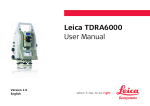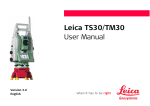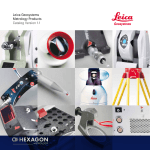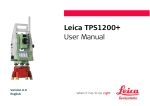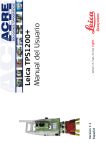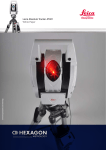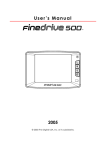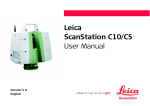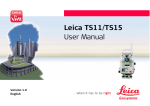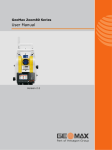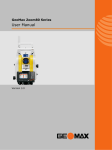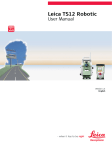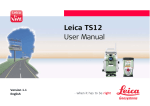Download Leica TM6100A User Manual
Transcript
Leica TM6100A User Manual Version 1.0 English TM6100A Introduction 2 Introduction Purchase Congratulations on the purchase of a TM6100A instrument. This manual contains important safety directions as well as instructions for setting up the product and operating it. Refer to "6 Safety Directions" for further information. Read carefully through the User Manual before you switch on the product. Product identification The type and the serial number of your product are indicated on the type plate. Enter the type and serial number in your manual and always refer to this information when you need to contact your agency or Leica Geosystems authorized service workshop. Type: _______________ Serial No.: _______________ Symbols The symbols used in this manual have the following meanings: Type Danger Warning Caution Description Indicates an imminently hazardous situation which, if not avoided, will result in death or serious injury. Indicates a potentially hazardous situation or an unintended use which, if not avoided, could result in death or serious injury. Indicates a potentially hazardous situation or an unintended use which, if not avoided, may result in minor or moderate injury and/or appreciable material, financial and environmental damage. Important paragraphs which must be adhered to in practice as they enable the product to be used in a technically correct and efficient manner. Trademarks • CompactFlash and CF are trademarks of SanDisk Corporation • Bluetooth is a registered trademark of Bluetooth SIG, Inc All other trademarks are the property of their respective owners. Validity of this manual Description General Introduction This manual applies to all TM6100A instruments. TM6100A 3 TM6100A Introduction Available documentation Name Description and Format User Manual All instructions required in order to operate the product to a basic level are contained in the User Manual. Provides an overview of the product together with technical data and safety directions. Name Description and Format System Field Manual Describes the general working of the product in standard use and specific onboard application programs. Intended as a quick reference field guide. Technical Reference Manual Overall comprehensive guide to the product and program functions. Included are detailed descriptions of special software/hardware settings and software/hardware functions intended for technical specialists. Refer to the following resources for all TM6100A documentation and software • the TPS6000 Product CD • http://metrology.leica-geosystems.com/en/Downloads_6843.htm 4 Table of Contents In this manual Chapter 1 Description of the System 1.1 1.2 1.3 1.4 2 3 Table of Contents Page System Components System Concept 1.2.1 Software Concept 1.2.2 Data Storage and Data Conversion Concept 1.2.3 Power Concept Container Contents Instrument Components 8 8 11 11 13 15 16 17 User Interface 20 2.1 2.2 2.3 2.4 2.5 20 24 27 29 35 Keyboard Hot Key Assignments Screen Operating Principles Icons Operation 37 3.1 3.2 37 40 40 Instrument Setup Battery 3.2.1 Operating Principles TM6100A 5 TM6100A Table of Contents 3.3 3.4 3.5 3.6 3.7 4 5 3.2.2 Instrument Battery Working with the CompactFlash Card Accessing Survey Application Program Built-in autocollimation device Connection to Application Computer Limitation of the horizontal and vertical movements 6 41 43 46 49 51 55 Check & Adjust 60 4.1 4.2 4.3 4.4 4.5 4.6 4.7 4.8 4.9 60 63 65 69 74 76 77 79 80 Overview Preparation Combined Adjustment (l, t, i and c) Tilting Axis Adjustment (a) Adjusting the Circular Level of the Instrument and Tribrach Adjusting the Circular Level of the Prism Pole Inspecting the Laser Plummet of the Instrument Servicing the Tripod Adjustment of the autocollimation reticule Care and Transport 82 5.1 5.2 5.3 5.4 82 84 85 87 Transport Storage Cleaning and Drying Maintenance 6 Safety Directions 6.1 6.2 6.3 6.4 6.5 6.6 6.7 6.8 7 Table of Contents General Introduction Intended Use Limits of Use Responsibilities Hazards of Use Laser Classification 6.6.1 General 6.6.2 Laser Plummet Electromagnetic Compatibility EMC FCC Statement, Applicable in U.S. 88 89 91 92 93 99 99 101 104 107 Technical Data 110 7.1 7.2 110 111 111 112 7.3 8 88 Angle Measurement Conformity to National Regulations 7.2.1 Communication side cover with Bluetooth General Technical Data of the Instrument International Limited Warranty, Software License Agreement TM6100A 119 7 TM6100A Description of the System 1 Description of the System 1.1 System Components 1-8 Main components TM6100A_001 TM6100A Component Description TM6100A • an instrument of highest accuracy for measuring, calculating and capturing data. • connected with LGO Tools to view, exchange and manage data. Application Software Third party metrology software with an interface to the TM6100A for acquisition, analysis, management and reporting of data. LGO Tools An office software consisting of a suite of standard and extended programs for the viewing, exchange and management of data. Terminology The following terms and abbreviations may be found in this manual: Term Description TPS Total Station Positioning System LGO Tools LEICA Geo Office Tools Motorised TM6100A instruments are fitted with internal motors, enabling automatic horizontal and vertical turning are referred to as Motorised. Communication side cover Communication side cover with integrated Bluetooth is a component with external devices, i.e. laptop with application software. Description of the System TM6100A 1-9 Description of the System Instrument models LEICA Geo Office Tools TM6100A Model Description TM6100A Electronic theodolite, motorised, 0.5" accuracy. • • • 1 - 10 LGO Tools supports TM6100A instruments. It also supports all other Leica TPS instruments. LGO Tools is based on a graphical user interface with standard Windows® operating procedures. LGO Tools provides the following functionality: Functionality Description Standard Functionality Includes data exchange between computer and instrument, data management including viewing and editing, reporting, creation and management of codelists, creation and use of format files for data conversion, uploading and deleting of system software and application programs. • • Supported operating systems: Windows® XP, Windows® 2000. Refer to the online help of LGO Tools for additional information. 1.2 System Concept 1.2.1 Software Concept Description TM6100A instruments support the following types of software. Software type Software type Description System software This software comprises the central functions of the instrument. It is also referred to as firmware. The programs Survey and Setup are integrated into the firmware and cannot be deleted. The English language is integrated into the firmware and cannot be deleted. Language software Numerous languages are available for the TM6100A instruments. This software is also referred to as system language. The system software enables a maximum of three languages which can be stored at any one time - the English language and two other languages. The English language is the default language and cannot be deleted. One language is chosen as the active language. Description of the System TM6100A 1 - 11 Description of the System TM6100A 1 - 12 Software type Description Application programs A suite of optional specific application programs are available for the instrument. Some of the programs are activated freely and require no license key and others require purchasing and are only activated with a license key. Third party appli- There are various third party applications available for the cation programs TM6100A, onboard or computer based software. Please contact your Leica Geosystems representative for details. Customised application programs Software upload Customised software specific to user requirements can be developed using the GeoC++ development kit. Information on the GeoC++ development environment is available on request from a Leica Geosystems representative. All instrument software is stored in the System RAM of the instrument. The software can be uploaded onto the instrument using the following methods: • Using LGO Tools the software is transferred via the serial interface to the CompactFlash card in the instrument, which is then stored to the System RAM. • By connecting the CompactFlash card directly to the computer either via an internal card slot housing or an external OMNI drive, the software is transferred to the card, which is then stored to the System RAM. 1.2.2 Data Storage and Data Conversion Concept Description Data is stored within a job in a database on a memory device. This is either a CompactFlash card or an internal memory. Memory device CompactFlash card: Internal memory: A CompactFlash card housing is standard. A CompactFlash card can be inserted and removed. Available capacity: 256 MB and 1 GB. Whilst other CompactFlash cards may be used, Leica recommends Leica CompactFlash cards and cannot be held responsible for data loss or any other error that may occur when using a non-Leica card. An internal memory is always fitted. It resides inside the instrument. Available capacity: 256 MB. Unplugging connecting cables or removing the CompactFlash card during the measurement may cause loss of data. Always return to TM6100A Main Menu before removing the CompactFlash card and switch off the instrument before removing cables. Description of the System TM6100A 1 - 13 Description of the System Data conversion TM6100A 1 - 14 Export Data can be exported from a job in a wide range of ASCII formats. A standard set of Export Formats is delivered with the system. Customized export format can defined in Format Manager which is a PC tool in LEICA Geo Office Tools. Refer to the online help of LGO Tools for information on creating format files. Data can also be exported from a job in DXF or LandXML format. Import Data can be imported from ASCII, DXF, GSI8 or GSI16 format. Transfer raw data to LGO Tools Raw data can be transferred between the database on the CompactFlash card or the internal memory of the instrument and LGO Tools in two ways: • From the CompactFlash card or the internal memory directly via a serial interface to a project in LGO Tools on a PC. • From the CompactFlash card using for example an OMNI drive as supplied by Leica Geosystems to a project in LGO Tools on a PC. CompactFlash cards can be used directly in an OMNI drive as supported by Leica Geosystems. Other PC card drives may require an adapter. 1.2.3 Power Concept General Use the Leica Geosystems batteries, chargers and accessories or accessories recommended by Leica Geosystems to ensure the correct functionality of the instrument. Power options Instrument Power for the instrument can be supplied either internally or externally. An external battery is connected to the instrument using a LEMO cable. Internal battery: External battery: Description of the System One GEB241 battery fitted into the battery compartment. One GEB171 battery connected via cable TM6100A 1 - 15 Description of the System TM6100A 1.3 Container Contents Container for instrument and delivered accessories a f g h i j b c k l m d e TM6100A_039 n o 1 - 16 a) Protective cover for instrument and sunshade for objective lens b) Container straps c) Counterweight for diagonal eyepiece or zenith eyepiece - optional d) Allen key e) Spare stylus f) Room for normal handle g) Compact Flash card with cover h) User manual i) Autocollimation lamp AL51 - optional j) CompactFlash card adapter with cover optional k) Internal battery GEB241 - optional l) Instrument with supplied stylus and tribrach m) Data transfer cable GEV218 - optional n) Diagonal eyepiece GFZ3 or zenith eyepiece GOK6 (eyepiece for steep sighting) - optional o) Ball pen - optional 1.4 Instrument Components Instrument components part 1 of 2 The instrument components of a TM6100A instrument are shown below. a d TM6100A_002 Description of the System e f g b c h i a) b) c) d) e) f) g) h) i) TM6100A Carry handle Optical sight Panfocal telescope CompactFlash card compartment Horizontal drive User defined SmartKey Vertical drive Lemo connector Tribrach 1 - 17 TM6100A Description of the System Instrument components part 2 of 2 j n TM6100A_003 k o pq r l s 1 - 18 m j) k) l) m) n) o) p) q) r) s) Vertical drive Focusing ring Autocollimation device Interchangeable eyepiece Battery compartment Stylus for touch screen Screen Circular level Footscrew Keyboard Internal target An internal target GUS29 may be factory fitted to the telescope of the TM6100A to facilitate the mutual accurate collimation of two theodolites. Depending on the measurement task, the internal target can be rotated into or out of position. a b c TM6100A_004 a) TM6100A b) Knob to rotate internal target GUS29 c) Panfocal telescope The internal target GUS29 is rotated into the visible positions when the marker line on the knob is perpendicular to the line of sight. When the marker line on the knob is parallel to the line of sight, the internal target GUS29 is out of sight. Description of the System TM6100A 1 - 19 TM6100A User Interface 2 User Interface 2.1 Keyboard 20 Keyboard a ABC DEF 7 F12 8 9 MNO PQR 4 5 6 STU VWX 1 2 /$% _@& JKL F11 F10 F9 0 F8 CE F7 GHI b YZ 3 *?! . ESC USER c PROG OFF PgUp ON d SHIFT F1 F2 F3 F4 F5 e F6 PgDn TM6100A_005 f g a) b) c) d) Keys User Interface H Hot keys F7-F12 Alphanumeric keys CE, ESC, USER, PROG ENTER e) Arrow keys f) SHIFT g) Function keys F1-F6 Key Description Hot keys F7-F12 • Pre-defined keys to execute commands or access chosen screens. • The hot key F13, the user defined SmartKey, is located between the horizontal and vertical drive on the right hand side cover. Alphanumeric keys • To type letters and numbers. CE • • Clears all entry at the beginning of user input. Clears the last character during user input. ESC • Leaves the current menu or dialog without storing changes made. USER • Calls the user defined menu. PROG (ON) • • If the instrument is off: to turn instrument on. If the sensor is on: press at any time to select an application program. TM6100A 21 TM6100A User Interface Key Description ENTER • • • 22 Selects the highlighted line and leads to the next logical dialog/menu. Starts the edit mode for edit fields. Opens a list box. SHIFT • Changes between the first and the second level of function keys. Arrow keys • Move the focus on the screen. Function keys F1-F6 • Correspond to the six softkeys that appear on the bottom of the screen when the screen is activated. Key combinations User Interface Keys Description PROG plus USER Turns instrument off. SHIFT F12 Calls STATUS Level & Laser Plummet. SHIFT F11 Calls CONFIGURE Lights, Display, Beeps, Text, Lights page. SHIFT USER Calls QUICK SET Change Settings to:. SHIFT Pages up. SHIFT Pages down. TM6100A 23 TM6100A User Interface 24 2.2 Hot Key Assignments General TM6100A instruments contain two standard configurations at delivery. Two more configurations are available on the Factory CD. Configuration Set Description Angle Unit TM6100A BT Standard configuration set for Bluetooth connection Degree TM6100A Cable Standard configuration set for Cable connection Degree Hot Keys All default configurations contain the following Hot Key & Shift Hot Key assignments: Key Description F7 Autocollimation lamp On/Off F8 Reticule illumination On/Off F9 Change face F10 Position Hz/V F11 TPS Correction (Environmental Parameters) F12 Check & Adjust F13 (Trigger Key) Rec (Take an angle measurement) User Interface Shift - F7 Compensator functions Shift - F8 Telescope accessories Shift - F9 Units & Formats Shift - F10 Battery & Memory Status Shift - F11 Lights & Display Settings Shift - F12 Electronic Level & Plummet TM6100A 25 TM6100A User Interface Keyboard Overlay 26 A self adhesive keyboard overlay is available for the default Hot Key assignments. The keyboard overlay can be affixed to the keyboard as shown below if required. ABC DEF 7 F12 JKL GHI 8 9 MNO PQR F11 F10 F9 F8 CE F7 USER ESC PROG OFF PgUp SHIFT F1 F2 F3 F4 F5 F6 PgDn TM6100A_006 ON 2.3 Screen Screen a) b) c) d) e) f) g) h) i) j) k) Elements of the screen User Interface Time Caption Title Screen area Message line Icons ESC CAPS SHIFT icon Quick coding icon Softkeys Element Description Time The current local time is shown. Caption Shows location either in Main Menu, under PROG key or USER key. Title Name of the screen is shown. Screen area The working area of the screen. TM6100A 27 TM6100A User Interface Element 28 Description Message line Messages are shown for 10 s. Icons Shows current status information of the instrument. Refer to "2.5 Icons". Can be used with touch screen. ESC Can be used with touch screen. Same functionality as the fixed key ESC. The last operation will be undone. CAPS The caps mode for upper case letters is active.The caps mode is activated and deactivated by pressing UPPER (F5) or LOWER (F5) in some screens. SHIFT icon Shows the status of the SHIFT key; either first or second level of softkeys is selected. Can be used with touch screen and has the same functionality as the fixed key SHIFT. Quick coding icon Shows the quick coding configuration. Can be used with touch screen to turn quick coding on and off. Softkeys Commands can be executed using F1-F6 keys. The commands assigned to the softkeys are screen dependent. Can be used directly with touch screen. Scroll bar Scrolls the screen area up and down. 2.4 Operating Principles Keyboard and touch screen The user interface is operated either by the keyboard or by the touch screen with supplied stylus. The workflow is the same for keyboard and touch screen entry, the only difference lies in the way information is selected and entered. Turn instrument on Press and hold PROG for 2 s. Turn instrument off step-by-step Step Description The instrument can only be turned off in TM6100A Main Menu. Lock/Unlock keyboard User Interface 1. Press and hold both USER and PROG simultaneously. OR Press ESC for more then 2 s. 2. Press YES (F6) to continue or NO (F4) to cancel. Option Description Lock To lock the keyboard press and hold SHIFT for 3 s. The message ’Keyboard locked’ is momentarily displayed on the Message Line. Unlock To unlock the keyboard press and hold SHIFT for 3 s. The message ’Keyboard unlocked’ is momentarily displayed on the Message Line. TM6100A 29 TM6100A User Interface Selecting from a menu Appearance 30 Description To select an item from a menu, do one of the following: Move the focus to the item. ENTER or CONT (F1). OR Type the complete selection number in front of the item. ENTER or CONT (F1) are not required. OR Tap on the item with the stylus. Selecting a page Appearance Description To select a page in a screen, do one of the following: PAGE (F6). OR Tap on the page tab with the stylus. Edit an entire value in input fields Appearance Description 1. Highlight the field. 2. Type numeric and/or alphanumeric characters to overwrite. 3. ENTER or tap outside of the field. Edit an individual character in input fields Appearance Description A character can be inserted or overwritten. The procedure is the same for both cases. 1. Highlight the field. 2. For the keyboard: ENTER. The edit mode is activated where additional functions like insert and overwrite are available. 3. For the touch screen: Highlight the characters to be changed. 4. Type numeric and/or alphanumeric characters. 5. ENTER or tap outside of the field. User Interface TM6100A 31 TM6100A User Interface Access special alphanumeric characters for input Appearance and selection from a choicelist Step 32 Description 1. Highlight the input field. 2. For the keyboard: ENTER. 3. Toggle to the desired special character set by using the up/down arrow keys. 4. Press the function key assigned to the required character group. 5. Press the function key with the required character. 6. Repeat step 4. and 5. for entering more special characters of the same character set. 7. ENTER. Choicelists have various appearances. Closed choicelist Appearance Description Selection Triangles on the right indi- Use the arrow keys to cate further available change through the list or choices. tap the triangles on the screen. ENTER or tap on the field to access the choicelist. Opening a choicelist reveals either a simple listbox or a comprehensive listbox dialog. Simple listbox . Appearance Description • • • User Interface Selection Choicelist shows items • to select. A search field is shown • if necessary. A scroll bar is shown if necessary. TM6100A Highlight the item and ENTER. To exit without changes ESC, tap or outside the simple listbox. 33 TM6100A User Interface 34 Listbox dialog . Appearance Description • • • Selection Choicelist fills the • whole screen. A search field is • shown. A scroll bar is shown if necessary. • The functionality comprise adding, editing and deleting of items. • Listbox dialogs are explained in detail at appropriate places in the manuals. Highlight the item and CONT (F1). To exit without changes press ESC or tap . 2.5 Icons Description The screen icons display the current status information of the instrument. Position of the icons on the screen a) b) c) d) e) f) Icons Compensator/face I&II Bluetooth CompactFlash card/internal memory Battery SHIFT Quick coding Icon Description Reflector The currently active reflector is displayed. Compensator/face I&II Compensator off, out of range or face I&II icon is displayed. User Interface TM6100A 35 TM6100A User Interface Icon Description Bluetooth The status of each Bluetooth port and any Bluetooth connection is displayed. CompactFlash card/internal memory The status of the CompactFlash card and internal memory are displayed. • For the CompactFlash card, the capacity of used space is shown in seven levels. • 36 For the internal memory, the capacity of used memory is shown in nine levels. Battery The status and source of the battery is displayed. The percentage of remaining power capacity for all batteries are displayed numerically and graphically. For internal and external battery being attached at the same time the internal battery is used until it is empty and then the external battery is used. SHIFT The status of the SHIFT key is displayed. Quick coding Shows the quick coding configuration. Can be used with touch screen to turn quick coding on and off. 3 Operation 3.1 Instrument Setup Description This topic describes an instrument setup over a marked ground point using the laser plummet. It is always possible to set up the instrument without the need for a marked ground point. Important features: • It is always recommended to shield the instrument from direct sunlight and avoid uneven temperatures around the instrument. • The laser plummet described in this topic is built into the vertical axis of the instrument. It projects a red spot onto the ground, making it appreciably easier to centre the instrument. • The laser plummet cannot be used in conjunction with a tribrach equipped with an optical plummet. Operation TM6100A 37 TM6100A Operation 38 Setup step-by-step 7 2 SHIFT F12 3 6 1 1 5 1 5 4 5 TM6100A_007 Step Description Shield the instrument from direct sunlight and avoid uneven temperatures around the instrument. 1. Extend the tripod legs to allow for a comfortable working posture. Position the tripod over the marked ground point, centring it as well as possible. 2. Fasten the tribrach and instrument onto the tripod. Step Operation Description 3. Turn on the instrument by pressing PROG for 2 s. Press SHIFT (F12) to access STATUS Level & Laser Plummet, activating the laser plummet. 4. Move the tripod legs (1) and use the tribrach footscrews (6) to centre the plummet (4) over the ground point. 5. Adjust the tripod legs to level the circular level (7). 6. By using the electronic level turn the tribrach footscrews (6) to precisely level the instrument. 7. Centre the instrument precisely over the ground point (4) by shifting the tribrach on the tripod plate (2). 8. Repeat steps 6. and 7. until the required accuracy is achieved. TM6100A 39 TM6100A Operation 3.2 Battery 3.2.1 Operating Principles 40 Primary use/charging • The battery must be charged prior to using it for the first time because it is delivered with an energy content as low as possible. • For new batteries or batteries that have been stored for a long time (> three months), it is effectual to make only one charge/discharge cycle. • For Li-Ion batteries, a single discharging and charging cycle is sufficient. We recommend carrying out the process when the battery capacity indicated on the charger or on a Leica Geosystems product deviates significantly form the actual battery capacity available. • The permissible temperature range for charging is between 0°C to +40°C/+32°F to +104°F. For optimal charging we recommend charging the batteries at a low ambient temperature of +10°C to +20°C/+50°F to +68°F if possible. • It is normal for the battery to become warm during charging. Using the chargers recommended by Leica Geosystems, it is not possible to charge the battery if the temperature is too high. Operation/Discharging • The batteries can be operated from -20°C to +55°C/-4°F to +131°F. • Low operating temperatures reduce the capacity that can be drawn; very high operating temperatures reduce the service life of the battery. 3.2.2 Instrument Battery Change battery step-by-step 7 4 1 3 5 2 6 TM6100A_008 Step Operation Description 1. Face the instrument on the side with the single finedrive. The battery compartment is located just below. Turn the knob to the vertical position, opening the lid of the battery compartment. 2. Pull out the battery housing. 3. Pull the battery from the battery housing. TM6100A 41 TM6100A Operation Step 42 Description 4. A pictogram of the battery is displayed inside the battery housing. This is a visual aid to assist in placing the battery correctly. 5. Place the battery into the battery housing, ensuring that the contacts are facing outward. Click the battery into position. 6. Place the battery housing into the battery compartment. Push the battery housing in until it fits completely into the battery compartment. 7. Turn the knob to lock the battery compartment. Ensure that the knob is returned to its original horizontal position. 3.3 Working with the CompactFlash Card • • • • Keep the card dry. Use it only within the specified temperature range. Do not bend the card. Protect the card from direct impacts. Failure to follow these instructions could result in data loss and/or permanent damage to the card. Insert and remove a CompactFlash card step-by-step 7 1 5 2 3 4 6 TM6100A_009 Operation TM6100A 43 TM6100A Operation Step 44 Description 1. Face the instrument so that the CompactFlash card compartment is on the right side of the instrument. Turn the knob to the vertical position, opening the lid of the CompactFlash card compartment. 2. Open the lid of the CompactFlash card compartment. 3. Pull the front of the CompactFlash card up and take the card out of the lid. 4. Place the lower end of the CompactFlash card at the lower end of the CompactFlash card compartment. The extended edge of the card has to be on the upper side as shown on the pictogram in the CompactFlash card compartment. 5. Press the card down on the lid. 6. Close the lid. 7. Turn the knob to lock the CompactFlash card compartment. The lid is closed correctly when the knob is turned to a horizontal position. Format a CompactFlash card step-by-step Formatting the CompactFlash card before starting to store data is required if a completely new CompactFlash card is used or if all existing data needs to be deleted. Step Description 1. Main Menu: Tools...\Format Memory Device. 2. TOOLS Format Memory Device <Memory Device: CF Card> <Format Method: Format Quick> Select the memory device to be formatted. By activating the format command all data will be lost. Make sure that all important data on the CompactFlash card has been backed up before formatting the card. Before formatting the internal memory make sure that all important data is first transferred to the PC. To exit the screen without formatting the memory device, press ESC. This returns to the previous screen without execution of any command. 3. CONT (F1). 4. YES (F4) to complete the formatting of the CompactFlash card. NO (F6) to abort the formatting of the CompactFlash card and return to TOOLS Format Memory Device. 5. Operation Once the formatting of the CompactFlash card is completed the system returns to TM6100A Main Menu. TM6100A 45 TM6100A Operation 3.4 46 Accessing Survey Application Program Access Select Main Menu: Survey. OR Press PROG. Highlight Survey. CONT (F1). SURVEY Survey Begin CONT (F1) To accept changes and access the subsequent screen. The chosen settings become active. CONF (F2) To access SURVEY Configuration. SETUP (F3) Opens SETUP Station Setup to set station and orientation. CSYS (F6) To select a different coordinate system. Not available for <Use Auto CrdSys: Yes> configured in CONFIGURE Additional Rover Settings. Description of fields Field Option Description <Job:> Choicelist The active job. All jobs from Main Menu: Manage...\Jobs can be selected. <Coord System:> Output The coordinate system currently attached to the selected <Job:>. Cannot be edited for <Use AutoCrdSys: Yes> configured in CONFIGURE Additional Rover Settings. <Codelist:> Choicelist No codes are stored in the selected <Job:>. All codelists from Main Menu: Manage...\Codelists can be selected. Output Codes have already been stored in the selected <Job:>. If codes had been copied from a System RAM codelist, then the name of the codelist is displayed. If codes have not been copied from a System RAM codelist but typed in manually, then the name of the active job is displayed. Choicelist The active configuration set. All configuration sets from Main Menu: Manage...\Configuration Sets can be selected. <Config Set:> Operation TM6100A 47 TM6100A Operation Field Option 48 Description The instrument has numerous user configuration parameters and functions. This allows a variety of preferences to be addressed. The configuration of the parameters and functions for an individual measuring technique are combined in a configuration set. <Reflector:> Choicelist Displays the active reflector. All reflectors from Main Menu: Manage...\Reflectors. All listed reflectors can be selected. <Add. Constant:> Output Displays the additive constant stored with the chosen reflector. Next step CONT (F1) to access SURVEY Survey: Job Name, where measurements can be performed with ALL (F1) or DIST (F2) and/or REC (F3). 3.5 Built-in autocollimation device AL51 plug-in lamp The TM6100A is equipped with a built-in autocollimation device. To illuminate the autocollimation reticule and project it to an autocollimation mirror, plug the AL51 plug-in lamp into the socket on the telescope. Illumination To switch the illumination on or off select SHIFT (F11) to access CONFIGURE Lights Display, Beeps, Text. Highlight the line Autocollim, toggle On or Off and press to CONT (F1) to continue. The brightness of the autocollimation lamp may be adjusted by turning the knob on the autocollimation lamp. Operation TM6100A 49 TM6100A Operation 50 a TM6100A_041 a) Intensity actuator 3.6 Connection to Application Computer Connection types There are three basic connection types to connect a TM6100A to an application computer: • Cable connection via T-LINK • Cable connnection via USB Download Cable GEV218 or Y-Cable GEV220 • Wireless Bluetooth connection Operation TM6100A 51 TM6100A Operation T-LINK 52 The connection via T-LINK connects up to 8 TM6100A to an application computer. The connection requires the following components: • T-LINK • Data Cable GEV86-I (20 m) • Data transfer cable to RS232 port of the application computer. TM6100A_010 It is not recommended to upload any firmware or software via the T-LINK and the 20 m data cable. Use the short data cable or the USB Download Cable GEV218. Direct cable connection The direct cable connection connects a single instrument to an application computer. The connection requires the following components: • USB Download Cable GEV218 or Y-Cable GEV220 TM6100A_011 Operation TM6100A 53 TM6100A Operation Bluetooth connection 54 A Bluetooth connection to an application computer can be established through the internal bluetooth modul. The connection requires the following setup: • Paired bluetooth communication between TM6100A and application computer. TM6100A_012 3.7 Limitation of the horizontal and vertical movements General Due to the size of the panfocal telescope of the TM6100A a face change can only be done through the lens side. This requires a turning restriction for the vertical movement of the telescope. In addition the motorized horizontal movements can be restricted because of accesssories attached, i.e. Diode Laser DL2/3. If a turning restriction is defined, the TM6100A will not pass or enter a certain vertical or horizontal sector. Vertical Limitations The default limits for vertical movements are applied as shown below. Telescope side Range Value Eyepiece V Begin 55 gon V End 344 gon V Begin n/a V End n/a Lens Use Limit Operation Eyepiece TM6100A 55 TM6100A Operation 56 Free turning range for eyepiece: Zenith Lens Eyepiece 55 gon Lens Eyepiece 344 gon TM6100A_042 Custom limitations In case of additional accessories used on the telescope, Individual limitations can be applied to the horizontal and vertical movements. Access Select Main Menu: Config...\Instrument Settings...\Telescope Accessories. CONFIGURE, Telescope Accessories, Hz Limits CONT (F1) To accept changes and return to the TM6100A Main Menu. NEW (F2) To define new horizontal limits for motorized rotation. SHOW (F5) To position the telescope to its rotation limits. PAGE (F6) To change to another page on this screen. Description of fields: Operation Field Option Description <Hz Begin:> <Hz End:> Output/user Input The boundaries of the window within the instrument is allowed to turn. <Use Limit:> Yes Motorized instrument turning is restricted to the defined window. TM6100A 57 TM6100A Operation Field 58 Option Description No Instruments turns without any limitation. Next step PAGE (F6) to change to the V Limit page. CONFIGURE, Telescope Accessories, V Limits CONT (F1) To accept changes and return to the TM6100A Main Menu. NEW (F2) To define new horizontal limits for motorized rotation. SHOW (F5) To position the telescope to its rotation limits. PAGE (F6) To change to another page on this screen. Description of fields: Field Option Description <V Begin:> <V End:> Output/user Input Vertical extent of the window in which the instrument is allowed to turn the telescope. <Use Limit:> None Instruments turns without any limitation. Eyepiece The movement of the telescope is limited by the stored Eyepiece Accessories limits. Lens The movement of the telescope is limited by the stored Lens Accessories limits. Do not use with TM6100A. Eyepiece & Lens The movement of the telescope is limited by the combination of both areas with the least vertical extent. Operation TM6100A 59 TM6100A Check & Adjust 60 4 Check & Adjust 4.1 Overview Description Leica instruments are manufactured, assembled and adjusted to the best possible quality. Quick temperature changes, shock or stress can cause deviations and decrease the instrument accuracy. It is therefore recommended to check and adjust the instrument from time to time. This can be done in the field by running through specific measurement procedures. The procedures are guided and have to be followed carefully and precisely as described in the following chapters. Some other instrument errors and mechanical parts can be adjusted mechanically. Electronic adjustment The following instrument errors can be checked and adjusted electronically: l, t i c a Compensator longitudinal and transversal index errors Vertical index error, related to the standing axis Hz collimation error, also called line of sight error Tilting axis error Every angle measured in the daily work is corrected automatically if the compensator and the Hz-corrections are activated in the instrument configuration. Select Main Menu: Config...\Instrument Settings...\Compensator to check the settings. View current adjustment errors The currently used adjustment errors can be viewed under Main Menu: Tools.../Check & Adjust...\Current Values. Mechanical adjustment The following instrument parts can be adjusted mechanically: Precise measurements To • • • • • • • Circular level on instrument and tribrach Laser plummet Optical plummet - option on tribrach Allen screws on tripod get precise measurements in the daily work, it is important: To check and adjust the instrument from time to time. To take high precision measurements during the check and adjust procedures. To measure targets in two faces. Some of the instrument errors are eliminated by averaging the angles from both faces. • Refer to "4.2 Preparation" to find more important points. During the manufacturing process, the instrument errors are carefully determined and set to zero. As mentioned above, these errors can change and it is highly recommended to redetermine them in the following situations: • Before the first use • Before every high precision survey • After rough or long transportations • After long working periods Check & Adjust TM6100A 61 TM6100A Check & Adjust • • Summary of errors to be adjusted electronically 62 After long storage periods If the temperature difference between current environment and the temperature at the last calibration is more than 20°C Instrument error Effects Effects Elimination Hz V with two face measurement c - Line of sight error --- a - Tilting axis error l - Compensator index error ----- t - Compensator index error i - V-Index error ----- Automatically corrected with proper adjustment 4.2 Preparation Before determining the instrument errors, the instrument has to be levelledup using the electronic level. SHIFT F12 to access STATUS Level & Laser Plummet, Level page. The tribrach, the tripod and the underground should be very stable and secure from vibrations or other disturbances. The instrument should be protected from direct sunlight in order to avoid thermal warming. It is also recommended to avoid strong heat shimmer and air turbulence. The best conditions are usually early in the morning or with overcast sky. Before starting to work, the instrument has to become acclimatised to the ambient temperature. Approximately two minutes per °C of temperature difference from storage to working environment but at least 15 min should be taken into account. Take the carry handle off the TM6100A when calibrating and measuring as the telescope may not turn to the second face with the carry handle mounted. Generally calibration and measurement set up should be carried out with the same instrument configuration. Check & Adjust TM6100A 63 TM6100A Check & Adjust Next step 64 IF the task is to THEN adjust a combination of instrument errors Refer to "4.3 Combined Adjustment (l, t, i and c)" adjust the tilting axis Refer to "4.4 Tilting Axis Adjustment (a)" adjust the circular level Refer to "4.5 Adjusting the Circular Level of the Instrument and Tribrach" adjust the laser/optical plummet Refer to "4.7 Inspecting the Laser Plummet of the Instrument" adjust the tripod Refer to "4.8 Servicing the Tripod" 4.3 Combined Adjustment (l, t, i and c) Description The combined adjustment procedure determines the following instrument errors in one process: l, t i c Combined adjustment procedure step-by-step Compensator longitudinal and transversal index errors Vertical index error, related to the standing axis Hz collimation error, also called line of sight error The following table explains the most common settings. Step Description 1. Main Menu: Tools...\Check & Adjust... 2. TOOLS Check & Adjust Menu Select the option: Combined (l,t,i,c,ATR) 3. Check & Adjust TOOLS Combined I TM6100A 65 TM6100A Check & Adjust Step 66 Description 4. ~* m ± 9° Aim the telescope accurately at a target at about the usual working distance. The target must be positioned within ± 9°/± 10 gon of the horizontal plane. The procedure can be started in any telescope face. *: Typical working distance, minimum 15 meter. TM6100A_013 Step 5. Description MEAS (F1) to measure and to continue to the next screen. TM6100A are motorised instruments and change automatically to the other face. 180° The fine pointing has to be performed manually in both faces. 180° TM6100A_014 6. TOOLS Combined II MEAS (F1) to measure the same target in the other face and to calculate the instrument errors. If one or more errors are bigger than the predefined limits, the procedure has to be repeated. All measurements of the current run are rejected and none of them is averaged with the results from previous runs. 7. Check & Adjust TOOLS Adjustment Accuracy TM6100A 67 TM6100A Check & Adjust Step 68 Description <No.of Meas:> Shows the number of runs executed. One run consists of a measurement in face I and face II. <σ l Comp:> and similar lines show the standard deviations of the determined adjustment errors. The standard deviations can be calculated from the second run onwards. It is recommended to measure at least two runs. 8. MEAS (F5) if more runs have to be added. Continue with step 3. OR CONT (F1) to accept the measurements and to proceed to TOOLS Adjustment Results. No more runs can be added later. Next step IF the results are THEN to be stored CONT (F1) overwrites the old adjustment errors with the new ones, if the Use status is set to Yes. to be determined again REDO (F2) rejects all new determined adjustment errors and repeats the whole procedure. Refer to step 3. of paragraph "Combined adjustment procedure step-by-step". 4.4 Tilting Axis Adjustment (a) Description This adjustment procedure determines the following instrument error: a Determination of tilting axis error step-by-step Tilting axis error The following table explains the most common settings. Step Description The Hz collimation error (c) has to be determined before starting this procedure. 1. Main Menu: Tools...\Check & Adjust... 2. TOOLS Check & Adjust Menu Select the option: Tilting Axis (a) Check & Adjust TM6100A 69 TM6100A Check & Adjust Step 3. 70 Description TOOLS Tilting-Axis Adjustment I Aim the telescope accurately at a target at about the usual working distance. The target must be positioned at least 27°/30 gon above or beneath the horizontal plane. ° The procedure can be started in any tele+ 27° 90 = V scope face. - 27° TM6100A_015 Step 4. Description MEAS (F1) to measure and to continue to the next screen. TM6100A are motorised instruments and change automatically to the other face. + 27° 180° 9 V= 0° The fine pointing has to be performed manually in both faces. - 27° 180° TM6100A_040 5. TOOLS Tilting-Axis Adjustment II MEAS (F1) to measure the same target in the other face and to calculate the tilting axis error. Check & Adjust TM6100A 71 TM6100A Check & Adjust Step 72 Description If the error is bigger than the predefined limit, the procedure has to be repeated. The tilting axis measurements of the current run are then rejected and not averaged with the results from previous runs. 6. TOOLS T-Axis Adjustment Accuracy <No.of Meas:> Shows the number of runs executed. One run consists of a measurement in face I and face II. <σ a T-axis:> shows the standard deviation of the determined tilting axis error. The standard deviation can be calculated from the second run onwards. It is recommended to measure at least two runs. 7. MEAS (F5) if more runs have to be added. Continue with step 3. OR CONT (F1) to accept the measurements and to proceed to TOOLS T-Axis Adjustment Result. No more runs can be added later. Next step Check & Adjust IF the results are THEN to be stored CONT (F1) overwrites the old tilting axis error with the new one. to be determined again REDO (F2) rejects the new determined tilting axis error and repeats the whole procedure. Refer to step 3. of paragraph "Determination of tilting axis error step-by-step". TM6100A 73 TM6100A Check & Adjust 4.5 74 Adjusting the Circular Level of the Instrument and Tribrach Adjusting the circular level step-by-step 1 4 SHIFT F12 4 2 TM6100A 016 Step Description 1. Place and secure the instrument into the tribrach and onto a tripod. 2. Using the tribrach footscrews, level the instrument with the electronic level. SHIFT (F12) to access STATUS Level & Laser Plummet. 3. Check the position of the circular level on the instrument and tribrach. 4. a) If both circular levels are centered, no adjustments are necessary b) If one or both circular levels are not centered, adjust as follows: Step Description Instrument: If it extends beyond the circle, use the supplied allen key to centre it with the adjustment screws. Turn the instrument by 200 gon (180°). Repeat the adjustment procedure if the circular level does not stay centered. Tribrach: If it extends beyond the circle, use the supplied allen key to centre it with the adjustment screws. After the adjustments, all adjusting screws should have the same tightening tension and no adjusting screw shall be loose. Check & Adjust TM6100A 75 TM6100A Check & Adjust 4.6 Adjusting the circular level step-by-step 76 Adjusting the Circular Level of the Prism Pole Step Description 1. Suspend a plumb line. 2. Using a pole bipod, align the prism pole parallel to the plumb line. 3. Check the position of the circular level on the prism pole. 4. a) If the circular level is centered, no adjustment is necessary. b) If the circular level is not centered, use an allen key to centre it with the adjustment screws. 4b 1 2 4a TM6100A_017 After the adjustments, all adjusting screws should have the same tightening tension and no adjusting screw shall be loose. 4.7 Inspecting the Laser Plummet of the Instrument The laser plummet is located in the vertical axis of the instrument. Under normal conditions of use, the laser plummet does not need adjusting. If an adjustment is necessary due to external influences, the instrument has to be returned to any Leica Geosystems authorized service workshop. Inspecting the laser plummet step-by-step 1 2 3 5 360° SHIFT F12 Ø 2.5 mm / 1.5 m F6 4 6 ≤ 3 mm / 1.5 m TM6100A_018 The following table explains the most common settings. Check & Adjust TM6100A 77 TM6100A Check & Adjust Step 78 Description 1. Place and secure the instrument into the tribrach and onto a tripod. 2. Using the tribrach footscrews, level the instrument with the electronic level. SHIFT (F12) to access STATUS Level & Laser Plummet. 3. PAGE (F6) to access the Laser Plummet page. Switch on the laser plummet. Inspection of the laser plummet should be carried out on a bright, smooth and horizontal surface, like a sheet of paper. 4. Mark the centre of the red dot on the ground. 5. Turn the instrument through 360° slowly, carefully observing the movement of the red laser dot. The maximum diameter of the circular movement described by the centre of the laser point should not exceed 3 mm at a distance of 1.5 m. 6. If the centre of the laser dot describes a perceptible circular movement or moves more than 3 mm away from the point which was first marked, an adjustment may be required. Inform your nearest Leica Geosystems authorized service workshop. Depending on brightness and surface, the diameter of the laser dot can vary. At 1.5 m it is about 2.5 mm. 4.8 Servicing the Tripod Servicing the tripod step-by-step 2 1 3 TM6100A_019 The following table explains the most common settings. Step Description The connections between metal and timber components must always be firm and tight. Check & Adjust 1. Tighten the leg cap screws moderately, with the supplied allen key. 2. Tighten the articulated joints on the tripod head just enough to keep the tripod legs open when lifting the tripod off the ground. 3. Tighten the allen screws of the tripod legs. TM6100A 79 Check & Adjust TM6100A 80 4.9 Adjustment of the autocollimation reticule Description The built-in autocollimation device has an additional "negative" reticle, which is projected through the telescope and observed by the linear cross of the standard reticule. To achieve accurate results the negative reticule must coincide to the standard reticule. Check Set up an autocollimation mirror about 5 m (16 ft) from the instrument. Adjust the reflecting surface perpendicular to the telescope’s line of sight. Adjust the telescope to focus on the image of the negative linear cross reflected by the mirror, i.e. focus to double the distance between telescope and mirror. Do not focus to infinity. The standard black reticule and the negative green linear cross should be aligned and centered. When moving the telescope over the mirror both reticules stay aligned. Adjustment If the two crosshairs do not coincide. adjust by means of the four setting screws (1 to 4). Screws 1 and 2 move the negative reticule sideways, screws 3 and 4 move it up and down. These screws are paired and act reciprocal. When loosening one of a pair, immediately tighten the other one by the same amount. Do not over tighten! To access screw 4 remove the metal cover plate by unscrewing the slotted screw. 2 3 1 4 TM6100A_020 Check & Adjust TM6100A 81 TM6100A Care and Transport 82 5 Care and Transport 5.1 Transport Telescope protection cushion To protect the telescope from damage, a protection cushion holds the telescope in a particular position when the instrument is stored in the transport container. Position the telescope and attach the protection cushion according to the picture located on the bottom of the transport container. Transport in the field When transporting the equipment in the field, always make sure that you • either carry the product in its original transport container, • or carry the tripod with its legs splayed across your shoulder, keeping the attached product upright. Transport in a road vehicle Never carry the product loose in a road vehicle, as it can be affected by shock and vibration. Always carry the product in its transport container and secure it. Shipping When transporting the product by rail, air or sea, always use the complete original Leica Geosystems packaging, transport container and cardboard box, or its equivalent, to protect against shock and vibration. Shipping, transport of batteries When transporting or shipping batteries, the person in charge of the product must ensure that the applicable national and international rules and regulations are observed. Before transportation or shipping, contact your local passenger or freight transport company. Field adjustment After transport inspect the field adjustment parameters given in this user manual before using the product. Care and Transport TM6100A 83 TM6100A Care and Transport 84 5.2 Storage Product Respect the temperature limits when storing the equipment, particularly in summer if the equipment is inside a vehicle. Refer to "7 Technical Data" for information about temperature limits. Field adjustment After long periods of storage inspect the field adjustment parameters given in this user manual before using the product. Li-Ion batteries • • • • • • Refer to "7.3 General Technical Data of the Instrument" for information about storage temperature range. A storage temperature range of -20°C to +30°C/-4°F to +86°F in a dry environment is recommended to minimize self-discharging of the battery. At the recommended storage temperature range, batteries containing a 10% to 50% charge can be stored for up to one year. After this storage period the batteries must be recharged. Remove batteries from the product and the charger before storing. After storage recharge batteries before using. Protect batteries from damp and wetness. Wet or damp batteries must be dried before storing or use. 5.3 Cleaning and Drying Product and accessories • • • Fogging of prisms Reflector prisms that are cooler than the ambient temperature tend to fog. It is not enough simply to wipe them. Keep them for some time inside your jacket or in the vehicle to allow them to adjust to the ambient temperature. Damp products Dry the product, the transport container, the foam inserts and the accessories at a temperature not greater than 40°C / 104°F and clean them. Do not repack until everything is completely dry. Always close the transport container when using in the field. Care and Transport Blow dust off lenses and prisms. Never touch the glass with your fingers. Use only a clean, soft, lint-free cloth for cleaning. If necessary, moisten the cloth with water or pure alcohol. Do not use other liquids; these may attack the polymer components. TM6100A 85 Care and Transport Cables and plugs TM6100A 86 Keep plugs clean and dry. Blow away any dirt lodged in the plugs of the connecting cables. 5.4 Maintenance An inspection of the product must be done in a Leica Geosystems authorized service workshop. Leica Geosystems recommends an inspection of the product every 24 months. As TM6100A instruments are equipped with a self-surveillance system designed for maximum motor performance and long maintenance cycles Leica Geosystems recommends inspection of the product whenever indicated in the message line of the user interface. Care and Transport TM6100A 87 Safety Directions TM6100A 88 6 Safety Directions 6.1 General Introduction Description The following directions should enable the person responsible for the product, and the person who actually uses the equipment, to anticipate and avoid operational hazards. The person responsible for the product must ensure that all users understand these directions and adhere to them. 6.2 Intended Use Permitted use • • • • • • • • Adverse use • • • • • • • • Safety Directions Measuring horizontal and vertical angles. Recording measurements. Visualizing the aiming direction and vertical axis. Remote control of product. Data communication with external appliances. Transmission of measurement data to an external application PC. Transmission of coordinates from an external application PC to the product for inspection and build measurements. Computing by means of software. Use of the product without instruction. Use outside of the intended limits. Disabling safety systems. Removal of hazard notices. Opening the product using tools, for example screwdriver, unless this is specifically permitted for certain functions. Modification or conversion of the product. Use after misappropriation. Use of products with obviously recognizable damages or defects. TM6100A 89 TM6100A Safety Directions • • • • • Warning 90 Use with accessories from other manufacturers without the prior explicit approval of Leica Geosystems. Aiming directly into the sun. Inadequate safeguards at the working site, for example when measuring on roads. Deliberate dazzling of third parties. Controlling of machines, moving objects or similar monitoring application without additional control- and safety installations. Adverse use can lead to injury, malfunction and damage. It is the task of the person responsible for the equipment to inform the user about hazards and how to counteract them. The product is not to be operated until the user has been instructed on how to work with it. 6.3 Limits of Use Environment Suitable for use in an atmosphere appropriate for permanent human habitation: not suitable for use in aggressive or explosive environments. Danger Safety Directions Local safety authorities and safety experts must be contacted before working in hazardous areas, or in close proximity to electrical installations or similar situations by the person in charge of the product. TM6100A 91 TM6100A Safety Directions 92 6.4 Responsibilities Manufacturer of the product Leica Geosystems AG, CH-9435 Heerbrugg, hereinafter referred to as Leica Geosystems, is responsible for supplying the product, including the user manual and original accessories, in a completely safe condition. Manufacturers of non Leica Geosystems accessories The manufacturers of non Leica Geosystems accessories for the product are responsible for developing, implementing and communicating safety concepts for their products, and are also responsible for the effectiveness of those safety concepts in combination with the Leica Geosystems product. Person in charge of the product The person in charge of the product has the following duties: • To understand the safety instructions on the product and the instructions in the user manual. • To be familiar with local regulations relating to safety and accident prevention. • To inform Leica Geosystems immediately if the product and the application becomes unsafe. • To ensure that the national laws, regulations and conditions for the operation of radio transmitters are respected. Warning The person responsible for the product must ensure that it is used in accordance with the instructions. This person is also accountable for the training and the deployment of personnel who use the product and for the safety of the equipment in use. 6.5 Warning Caution Caution Safety Directions Hazards of Use The absence of instruction, or the inadequate imparting of instruction, can lead to incorrect or adverse use, and can give rise to accidents with far-reaching human, material, financial and environmental consequences. Precautions: All users must follow the safety directions given by the manufacturer and the directions of the person responsible for the product. Watch out for erroneous measurement results if the product has been dropped or has been misused, modified, stored for long periods or transported. Precautions: Periodically carry out test measurements and perform the field adjustments indicated in the user manual, particularly after the product has been subjected to abnormal use and before and after important measurements. Reflectors can cause personal injury and/or mechanical damage, when dropped. Precautions: Secure the reflector with a lanyard when moving the reflector. TM6100A 93 Safety Directions Warning Danger Caution TM6100A 94 Mounting the sensor on unstable or uneven ground may cause the sensor to tip over or cause unreliable measurement results. Precautions: Ensure the ground is stable and even. Do not place the sensor over cracks in the floor. Because of the risk of electrocution, it is very dangerous to use poles and extensions in the vicinity of electrical installations such as power cables or electrical railways. Precautions: Keep at a safe distance from electrical installations. If it is essential to work in this environment, first contact the safety authorities responsible for the electrical installations and follow their instructions. With the remote control of products, it is possible that extraneous targets will be picked out and measured. Precautions: When measuring in remote control mode, always check your results for plausibility. Warning Caution Warning Warning Safety Directions If the product is used with accessories, for example masts, staffs, poles, you may increase the risk of being struck by lightning. Precautions: Do not use the product in a thunderstorm. Be careful when pointing the product towards the sun, because the telescope functions as a magnifying glass and can injure your eyes and/or cause damage inside the product. Precautions: Do not point the product directly at the sun. During dynamic applications, for example stakeout procedures there is a danger of accidents occurring if the user does not pay attention to the environmental conditions around, for example obstacles, excavations or traffic. Precautions: The person responsible for the product must make all users fully aware of the existing dangers. Inadequate securing of the measurement site can lead to dangerous situations, especially at industrial installations. Precautions: Always ensure that the measurement site is adequately secured. Adhere to the regulations governing safety and accident prevention and road traffic. TM6100A 95 Safety Directions Warning Warning Caution Caution TM6100A 96 Only Leica Geosystems authorized service workshops are entitled to repair these products. If computers intended for use indoors are used in the field there is a danger of electric shock. Precautions: Adhere to the instructions given by the computer manufacturer with regard to field use in conjunction with Leica Geosystems products. If the accessories used with the product are not properly secured and the product is subjected to mechanical shock, for example blows or falling, the product may be damaged or people may sustain injury. Precautions: When setting-up the product, make sure that the accessories are correctly adapted, fitted, secured, and locked in position. Avoid subjecting the product to mechanical stress. During the transport, shipping or disposal of batteries it is possible for inappropriate mechanical influences to constitute a fire hazard. Precautions: Before shipping the product or disposing of it, discharge the batteries by running the product until they are flat. When transporting or shipping batteries, the person in charge of the product must ensure that the applicable national and international rules and regulations are observed. Before transportation or shipping contact your local passenger or freight transport company. Warning Warning Warning Warning Safety Directions Using a battery charger not recommended by Leica Geosystems can destroy the batteries. This can cause fire or explosions. Precautions: Only use chargers recommended by Leica Geosystems to charge the batteries. High mechanical stress, high ambient temperatures or immersion into fluids can cause leakage, fire or explosions of the batteries. Precautions: Protect the batteries from mechanical influences and high ambient temperatures. Do not drop or immerse batteries into fluids. Short circuited battery terminals can overheat and cause injury or fire, for example by storing or transporting in pockets if battery terminals come in contact with jewellery, keys, metallized paper or other metals. Precautions: Make sure that the battery terminals do not come into contact with metallic objects. If the product is improperly disposed of, the following can happen: • If polymer parts are burnt, poisonous gases are produced which may impair health. TM6100A 97 TM6100A Safety Directions 98 • If batteries are damaged or are heated strongly, they can explode and cause poisoning, burning, corrosion or environmental contamination. • By disposing of the product irresponsibly you may enable unauthorized persons to use it in contravention of the regulations, exposing themselves and third parties to the risk of severe injury and rendering the environment liable to contamination. • Improper disposal of silicone oil may cause environmental contamination. Precautions: The product must not be disposed with household waste. Dispose of the product appropriately in accordance with the national regulations in force in your country. Always prevent access to the product by unauthorized personnel. Product specific treatment and waste management information can be downloaded from the Leica Geosystems home page at http://www.leica-geosystems.com/treatment or received from your Leica Geosystems dealer. 6.6 Laser Classification 6.6.1 General General The following directions (in accordance with the state of the art - international standard IEC 60825-1 (2007-03) and IEC TR 60825-14 (2004-02)) provide instruction and training information to the person responsible for the product and the person who actually uses the equipment, to anticipate and avoid operational hazards. The person responsible for the product must ensure that all users understand these directions and adhere to them. Products classified as laser class 1, class 2 and class 3R do not require: • laser safety officer involvement, • protective clothes and eye wear, • special warning signs in the laser working area if used and operated as defined in this user manual due to the low eye hazard level. Products classified as laser class 2 or class 3R may cause dazzle, flashblindness and afterimages, particularly under low ambient light conditions. Safety Directions TM6100A 99 TM6100A Safety Directions 100 Labelling Type: TM6100A Equip.No.: . . . . . . Power: 12V/14,8V ---, 2,5A max Leica Geosystems AG CH-9435 Heerbrugg Manufactured: . . . . 25 Made in Switzerland Art.No.: 576372 S.No.: ..... Complies with FDA performance standards for laser products except for deviations pursant to Laser Notice No.50, dated June 24, 2007. This device complies with part 15 of the FCC Rules. Operation is subject to the following two conditions: (1) This device may not cause harmful interference, and (2) this device must accept any interference received, including interference that may cause undesired operation. TM6100A_024 6.6.2 Laser Plummet General The laser plummet built into the product produces a visible red laser beam which emerges from the bottom of the product. The laser product described in this section, is classified as laser class 2 in accordance with: • IEC 60825-1 (2007-03): "Safety of laser products" • EN 60825-1 (2007-10): "Safety of laser products" Class 2 laser products: These products are safe for momentary exposures but can be hazardous for deliberate staring into the beam. Safety Directions Description Value Maximum average radiant power 1.00 mW Pulse duration c.w. Pulse repetition frequency c.w. Wavelength 620 nm - 690 nm TM6100A 101 TM6100A Safety Directions Warning 102 From a safety perspective class 2 laser products are not inherently safe for the eyes. Precautions: Avoid staring into the beam or pointing the beam at other people. Labelling Type: TM6100A Equip.No.: . . . . . . Power: 12V/14,8V ---, 2,5A max Leica Geosystems AG CH-9435 Heerbrugg Manufactured: . . . . 25 Made in Switzerland Art.No.: 576372 S.No.: ..... Complies with FDA performance standards for laser products except for deviations pursant to Laser Notice No.50, dated June 24, 2007. This device complies with part 15 of the FCC Rules. Operation is subject to the following two conditions: (1) This device may not cause harmful interference, and (2) this device must accept any interference received, including interference that may cause undesired operation. Laser Radiation Do not stare into the beam Class 2 Laser Product according to IEC 60825-1 ( 2007-03 ) Po ≤ 1.00 mW l = 620 - 690 nm TM6100A_022 b a TM6100A_023 a) Laser beam b) Exit for laser beam Safety Directions TM6100A 103 Safety Directions TM6100A 104 6.7 Electromagnetic Compatibility EMC Description The term Electromagnetic Compatibility is taken to mean the capability of the product to function smoothly in an environment where electromagnetic radiation and electrostatic discharges are present, and without causing electromagnetic disturbances to other equipment. Warning Electromagnetic radiation can cause disturbances in other equipment. Although the product meets the strict regulations and standards which are in force in this respect, Leica Geosystems cannot completely exclude the possibility that other equipment may be disturbed. Caution There is a risk that disturbances may be caused in other equipment if the product is used in conjunction with accessories from other manufacturers, for example field computers, personal computers, two-way radios, non-standard cables or external batteries. Precautions: Use only the equipment and accessories recommended by Leica Geosystems. When combined with the product, they meet the strict requirements stipulated by the guidelines and standards. When using computers and two-way radios, pay attention to the information about electromagnetic compatibility provided by the manufacturer. Caution Warning Safety Directions Disturbances caused by electromagnetic radiation can result in erroneous measurements. Although the product meets the strict regulations and standards which are in force in this respect, Leica Geosystems cannot completely exclude the possibility that the product may be disturbed by very intense electromagnetic radiation, for example, near radio transmitters, two-way radios or diesel generators. Precautions: Check the plausibility of results obtained under these conditions. If the product is operated with connecting cables attached at only one of their two ends, for example external supply cables, interface cables, the permitted level of electromagnetic radiation may be exceeded and the correct functioning of other products may be impaired. Precautions: While the product is in use, connecting cables, for example product to external battery, product to computer, must be connected at both ends. TM6100A 105 Safety Directions Radios or digital cellular phones Warning TM6100A 106 Use of product with radio or digital cellular phone devices: Electromagnetic radiation can cause disturbances in other equipment, in installations, in medical devices, for example pacemakers or hearing aids and in aircraft. It can also affect humans and animals. Precautions: Although the product meets in combination with radio or digital cellular phone devices recommended by Leica Geosystems the strict regulations and standards which are in force in this respect, Leica Geosystems cannot completely exclude the possibility that other equipment may be disturbed or that humans or animals may be affected. • Do not operate the product with radio or digital cellular phone devices in the vicinity of filling stations or chemical installations, or in other areas where an explosion hazard exists. • Do not operate the product with radio or digital cellular phone devices near to medical equipment. • Do not operate the product with radio or digital cellular phone devices in aircraft. • Do not operate the product with radio or digital cellular phone devices for long periods immediately next to your body. 6.8 FCC Statement, Applicable in U.S. Applicability The greyed paragraph below is only applicable for products of the TM6100A System without radio, digital cellular phone devices or Bluetooth. Warning This equipment has been tested and found to comply with the limits for a Class B digital device, pursuant to part 15 of the FCC rules. These limits are designed to provide reasonable protection against harmful interference in a residential installation. This equipment generates, uses and can radiate radio frequency energy and, if not installed and used in accordance with the instructions, may cause harmful interference to radio communications. However, there is no guarantee that interference will not occur in a particular installation. If this equipment does cause harmful interference to radio or television reception, which can be determined by turning the equipment off and on, the user is encouraged to try to correct the interference by one or more of the following measures: Safety Directions • • • Reorient or relocate the receiving antenna. Increase the separation between the equipment and the receiver. Connect the equipment into an outlet on a circuit different from that to which the receiver is connected. • Consult the dealer or an experienced radio/TV technician for help. TM6100A 107 TM6100A Safety Directions Warning 108 Changes or modifications not expressly approved by Leica Geosystems for compliance could void the user's authority to operate the equipment. Labelling TM6100A Type: TM6100A Equip.No.: . . . . . . Power: 12V/14,8V ---, 2,5A max Leica Geosystems AG CH-9435 Heerbrugg Manufactured: . . . . 25 Made in Switzerland Art.No.: 576372 S.No.: ..... Complies with FDA performance standards for laser products except for deviations pursant to Laser Notice No.50, dated June 24, 2007. This device complies with part 15 of the FCC Rules. Operation is subject to the following two conditions: (1) This device may not cause harmful interference, and (2) this device must accept any interference received, including interference that may cause undesired operation. TM6100A_024 .. ... ..... ... ... ... .. . .. ... ... ... ... ... .. ... .. ... ... ..... ... ... ... ... ... ... ... ... ... .. .. ... ... ... ... ..... ... ... ... ... ... ... . ... ... .. . ... .... ... ... .. ..... . .. ... ... ... ... ... ... ... ..... ... ... .... ... ... .. ... ... ... .... ... ... ... ... .. ...... ... .. .. .. Labelling internal battery GEB241 ... . . This device complies with part 15 of the FCC Rules. Operation is subject to the following two conditions: (1) This device may not cause harmful interference, and (2) this device must accept any interference received, including TM6100A_043 Safety Directions TM6100A 109 TM6100A Technical Data 7 Technical Data 7.1 Angle Measurement Accuracy Type TM6100A Characteristics Std. Dev. Hz, V, ISO 17123-3 110 Display least count ["] [mgon] ["] 0.5 0.15 0.01 Absolute, continuous, quadruple [mgon] 0.01 7.2 Conformity to National Regulations 7.2.1 Communication side cover with Bluetooth Conformity to national regulations • • • FCC Part 15 (applicable in US) Hereby, Leica Geosystems AG, declares that the Communication side cover with Bluetooth is in compliance with the essential requirements and other relevant provisions of Directive 1999/5/EC. The declaration of conformity may be consulted at http://www.leica-geosystems.com/ce. Class 1 equipment according European Directive 1999/5/EC (R&TTE) can be placed on the market and be put into service without restrictions in any EU Member state. The conformity for countries with other national regulations not covered by the FCC part 15 or European directive 1999/5/EC has to be approved prior to use and operation. Frequency band 2402 - 2480 MHz Output power Bluetooth: 5 mW Antenna Type Gain Internal Microstrip antenna 1.5 dBi Technical Data TM6100A 111 TM6100A Technical Data 112 7.3 General Technical Data of the Instrument Telescope Type Image Objective aperture Clear objective diameter: Focusing: Field of view and magnification Focussing distance ∞ Panfocal alignment telescope Erect 52 mm 40 mm Coarse and fine Field of view 1°08’ Magnification Standard Eyepiece Eyepiece FOK53 43 x 59 x 100 m 2.08 m 41 x 56 x 10 m 0.26 m 32 x 44 x 3m 0.11 m 24 x 33 x 0.6 m 0.04 m 13 x 18 x Focussing distance Telescope tilt Special features Compensator Shortest focussing distance Distance [m] From telescope front lens 0.51 From telescope tilting axis 0.60 Pointing direction Vertical Angle Telescope pointing down - 55° (-60 gon) Telescope pointing up + 47° (+52 gon) Feature Description Built-in autocollimation device Green negative crosshair Illumination AL51 plug-in lamp, keyboard switch Type TM6100A Level Technical Data Setting accuracy Setting range ["] [mgon] [’] [gon] 0.5 0.15 4 0.07 Compensation: Centralized quadruple axis compensation TM6100A 113 TM6100A Technical Data Control unit Circular level sensitivity: Electronic level resolution: 6’/2 mm 2" Display: 1/4 VGA (320 x 240 pixels), color, graphics capable LCD, illumination, touch screen 34 keys including 12 function keys, 12 alphanumeric keys and a user defined SmartKey, illumination 360°’", 360° decimal, 400 gon, 6400 mil, V % Face I (optional both faces) Toughened film on glass Keyboard: Angle Display: Position: Touch screen: Instrument Ports 114 Port Name Description Port 1 Port 1 • • 8 pin LEMO-1 for power, communication, data transfer. This port is located at the base of the instrument. Port 2 Handle • Not applicable Port 3 BT • • Bluetooth module for communication. This port is housed within Communication side cover. 351 mm 196 mm Instrument Dimensions 79 mm 248 mm TM6100A_025 Weight Technical Data Instrument: Tribrach: Internal battery GEB241: 114 mm 228 mm 7.25 kg 0.8 kg 0.43 kg TM6100A 115 TM6100A Technical Data Recording Laser plummet 116 Data can be recorded onto a CompactFlash card or into internal memory. Type Capacity [MB] Number of measurements per MB CompactFlash card • 256, 1024 1750 Internal memory • 256 1750 Type: Location: Accuracy: Diameter of laser point: Visible red laser class 2 In standing axis of instrument Deviation from plumbline: 1 mm at 1.5 m instrument height 2 mm at 1.5 m instrument height Operation Three endless drives: User defined Smartkey: For one and two hand manual operation Fast precision triggerkey for manual high precision measurements Motorisation Maximum acceleration: 400 gon/s2 200 gon/s Typically 2.9 s Maximum rotating speed: Time for change face: Power External supply voltage: Nominal voltage 12.8 V DC, Range 11.5 V-13.5 V Standby power consumption: Typically 5.9 W Internal battery Type: Voltage: Capacity: Typical operating time: Li-Ion 14.8 V GEB241: 4.8 Ah 9h External battery Type: Voltage: Capacity: Typical operating time: NiMH 12 V GEB171: 9.0 Ah 12 - 18 h Environmental specifications Temperature Technical Data Type Operating temperature [°C] Storage temperature [°C] TM6100A -20 to +50 -40 to +70 Leica CompactFlash cards, all sizes -40 to +80 -40 to +80 Battery internal -20 to +50 -40 to +70 Bluetooth -20 to +50 -40 to +70 TM6100A 117 TM6100A Technical Data Protection against water, dust and sand Type Protection TM6100A IP54 (IEC 60529) 118 Humidity Automatic corrections Type Protection TM6100A Max 95 % non condensing The effects of condensation are to be effectively counteracted by periodically drying out the instrument. The following automatic corrections are made: • • • • • • Line of sight error Tilting axis error Circle eccentricity Compensator index error Vertical index error Standing axis tilt 8 International Limited Warranty, Software License Agreement International Limited Warranty This product is subject to the terms and conditions set out in the International Limited Warranty which you can download from the Leica Geosystems home page at http://www.leica-geosystems.com/internationalwarranty or collect from your Leica Geosystems distributor. The foregoing warranty is exclusive and is in lieu of all other warranties, terms or conditions, express or implied, either in fact or by operation of law, statutory or otherwise, including warranties, terms or conditions of merchantability, fitness for a particular purpose, satisfactory quality and non-infringement, all of which are expressly disclaimed. Software License Agreement This product contains software that is preinstalled on the product, or that is supplied to you on a data carrier medium, or that can be downloaded by you online pursuant to prior authorization from Leica Geosystems. Such software is protected by copyright and other laws and its use is defined and regulated by the Leica Geosystems Software License Agreement, which covers aspects such as, but not limited to, Scope of the License, Warranty, Intellectual Property Rights, Limitation of Liability, Exclusion of other Assurances, Governing Law and Place of Jurisdiction. Please make sure, that at any time you fully comply with the terms and conditions of the Leica Geosystems Software License Agreement. International Limited Warranty, Software License Agreement TM6100A 119 International Limited Warranty, Software License Agreement TM6100A 120 Such agreement is provided together with all products and can also be referred to and downloaded at the Leica Geosystems home page at http://www.leica-geosystems.com/swlicense or collected from your Leica Geosystems distributor. You must not install or use the software unless you have read and accepted the terms and conditions of the Leica Geosystems Software License Agreement. Installation or use of the software or any part thereof, is deemed to be an acceptance of all the terms and conditions of such license agreement. If you do not agree to all or some of the terms of such license agreement, you may not download, install or use the software and you must return the unused software together with its accompanying documentation and the purchase receipt to the dealer from whom you purchased the product within ten (10) days of purchase to obtain a full refund of the purchase price. A Abbreviations ........................................................ 8 Acclimatise to the ambient temperature ............. 63 Accuracy Angle measurement ..................................... 110 Adjustment Combined (l, t, i, c and ATR) ........................... 65 Electronic ....................................................... 60 Inspecting the laser plummet ......................... 77 Mechanical ..................................................... 61 Of circular level on instrument ....................... 74 Of circular level on prism pole ........................ 76 Of circular level on tribrach ............................ 74 Of laser plummet ........................................... 77 Preparation .................................................... 63 Titling axis (a) ................................................ 69 Adjustment Errors View current .................................................. 61 Angle Measurement .......................................... 110 Antenna Communication side cover ........................... 111 Automatic Corrections ...................................... 118 B Battery For instrument ...............................................41 Icon ................................................................36 Overview ........................................................40 Technical data GEB171 .................................117 Technical data GEB241 .................................117 Bluetooth, icon ...................................................36 C CE .......................................................................21 Check & Adjust ....................................................60 Cleaning and Drying ............................................85 Communication side cover .....................................9 Technical data ..............................................111 CompactFlash Card ........................................13, 43 Format card ...................................................45 Icon ................................................................36 Insert card ......................................................43 Remove card ..................................................43 Safety instructions .........................................43 Compensator ....................................................113 Container Contents For instrument ...............................................16 TM6100A 121 TM6100A 122 Control unit ...................................................... 114 F Conversion, data conversion ............................... 14 FCC Statement ..................................................107 Corrections Frequency Band Automatic .................................................... 118 Communication side cover ............................111 D Data Conversion ................................................. 13 Data Storage ...................................................... 13 Dimensions Of instrument .............................................. 115 Documentation ..................................................... 4 Drive OMNI ............................................................. 14 Drives ............................................................... 116 E Edit Value in input field ......................................... 31 Electromagnetic Compatibility EMC .................... 104 Electronic Adjustment ......................................... 60 ENTER ................................................................. 22 Environmental Specifications ............................. 117 ESC ..................................................................... 21 G GeoC++ Software Development Kit ......................12 GUS29 .................................................................19 H Hazards of Use ....................................................93 I Icons Overview ........................................................35 Instrument Dimensions ..................................................115 Ports ............................................................114 Technical data ..............................................112 Turn on and turn off ......................................29 Weight .........................................................115 Instrument Components ......................................17 Instrument Models ..............................................10 Instrument Setup Conventional ..................................................37 Intended Use ...................................................... 89 Internal Memory ................................................. 13 Internal memory, icon ......................................... 36 Internal target .................................................... 19 LEICA Geo Office LGO Tools, description ..........8, 10 Level ...........................................................23, 113 Lights ..................................................................23 Lock, keyboard ....................................................29 K Keyboard ...................................................... 20, 29 Locking and unlocking .................................... 29 Operating principles ....................................... 29 Keys ................................................................... 21 Keys, Alphanumeric ............................................. 21 Keys, Arrow ........................................................ 22 Keys, Combinations ............................................ 23 Keys, Function .................................................... 22 Keys, Hot ............................................................ 21 M Maintenance .......................................................87 Manual Validity of user manual .....................................3 Mechanical Adjustment ........................................61 Menu, selecting from a ........................................30 O OMNI drive ..........................................................14 ON ......................................................................21 Operation .........................................................116 L Output Power Laser Classification ............................................. 99 Communication side cover ............................111 Electronic Guide Light EGL ............................ 101 Integrated Distancer, Invisible Laser ............. 100 P Laser Plummet ............................................. 101 Page, selecting from a .........................................30 PowerSearch PS ........................................... 101 Pages down ........................................................23 Pages up .............................................................23 Laser Plummet Adjustment .................................................... 77 Ports .................................................................114 Technical data .............................................. 116 Power Supply ......................................................15 TM6100A 123 TM6100A 124 PowerSearch PS ................................................ 111 Precise Measurements ........................................ 61 PROG .................................................................. 21 Language software .........................................11 Software type ................................................11 Software upload .............................................12 System software ............................................11 Q Software Concept ...............................................11 Quick coding, icon ............................................... 36 Storage ...............................................................84 Quick settings ..................................................... 23 Survey Application ...............................................46 System Concept ..................................................11 R Raw data transfer to LGO Tools .......................... 14 T Recording ......................................................... 116 Technical Data ...................................................110 Reflectors ......................................................... 118 Telescope ..........................................................112 Responsibilities ................................................... 92 Telescope Protection Cushion ..............................82 Temperature S Battery Internal Safety Directions ................................................ 88 Operating ................................................117 Screen ................................................................ 27 Storage ...................................................117 Scroll bar, description ......................................... 28 Bluetooth Service of tripod ................................................. 79 Operating ................................................117 Setup Storage ...................................................117 Conventional .................................................. 37 CompactFlash Card SHIFT ............................................................ 22, 36 Operating ................................................117 Software Storage ...................................................117 Application programs ..................................... 12 Instrument Customised application programs ................... 12 Operating ............................................... 117 Storage ................................................... 117 Terminology .......................................................... 8 T-LINK ................................................................. 52 Touch Screen, operating principles ...................... 29 Transfer raw data to LGO Tools .......................... 14 Transport ............................................................ 82 Tripod, service of ................................................ 79 U Unlock, keyboard ................................................ 29 USB Download Cable ........................................... 53 USER ................................................................... 21 User Interface ..................................................... 20 V Value, edit in input field ...................................... 31 View Current Adjustment Errors .......................... 61 W Weight Of instrument .............................................. 115 Y Y-Cable ............................................................... 53 TM6100A 125 Ask your local Leica Geosystems dealer for more information about our TQM program. Leica Geosystems AG Heinrich-Wild-Strasse CH-9435 Heerbrugg Switzerland Phone +41 71 727 31 31 www.leica-geosystems.com Original text Printed in Switzerland © 2009 Leica Geosystems AG, Heerbrugg, Switzerland Leica Geosystems AG, Heerbrugg, Switzerland, has been certified as being equipped with a quality system which meets the International Standards of Quality Management and Quality Systems (ISO standard 9001) and Environmental Management Systems (ISO standard 14001). 781366-1.0.2en Total Quality Management: Our commitment to total customer satisfaction.






























































































































